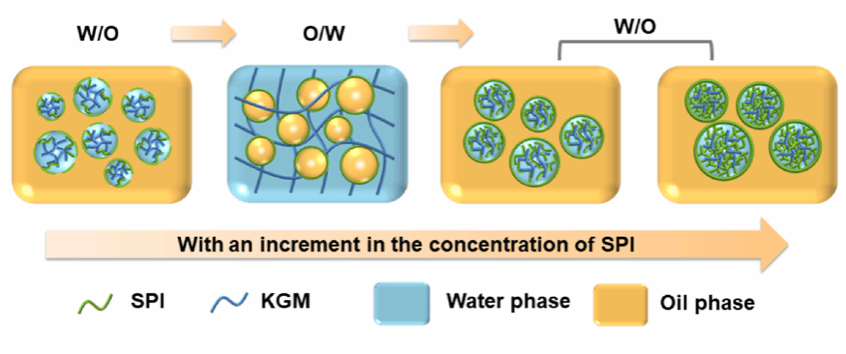Phase inversion of bigels tuned by the concentration of soy protein isolate in the binary hydrogel matrix
通过改变二元水凝胶基质中大豆分离蛋白的浓度 调控双凝胶的相反转
Abstract
Phase inversion of bigels is typically achieved by controlling the oleogel/hydrogel (OG/HG) ratio in previous studies. In this study, a binary hydrogel consisting of different concentrations of
soy protein isolate (SPI) to konjac glucomannan (KGM) was designed to fabricate bigels with ethyl cellulose (EC) oleogel at a fixed mass ratio of oleogel to hydrogel (OG:HG), and the phase inversion was subsequently achieved by increasing the concentration of SPI in the binary hydrogel, resulting in a transition from W/O to O/W bigels and then back to W/O bigels. Specifically, when the binary hydrogel contained 1 wt% SPI and 0.5 wt% KGM, the bigel type was O/W. A KGM network existed between the oil droplets of O/W bigels and within the internal phase of W/O bigels, with SPI being adsorbed at the oil-water interfaces of the bigels. As the concentration of SPI increased, the oil-water interfaces became progressively populated with proteins, leading to an increment in droplet diameter and a reduction in hardness, as well as an elevation of free water content within the bigels. This study proposes a novel operational strategy for controlling the phase inversion of bigels and developing encapsulation delivery systems by adjusting the concentration of SPI in binary hydrogels.
中文摘要:
在以往的研究中,通常通过控制油凝胶/水凝胶( OG / HG )的比例来实现双凝胶的相反转。在本研究中,设计了由不同浓度的大豆分离蛋白( SPI )和魔芋葡甘聚糖( KGM )组成的二元水凝胶,在油凝胶与水凝胶的质量比( OG:HG )固定的情况下与乙基纤维素( EC )油凝胶制备双凝胶,随后通过增加二元水凝胶中SPI的浓度来实现相转变,实现从油包水到水包油双凝胶再回到油包水双凝胶的转变。具体来说,当二元水凝胶中含有1wt %的SPI和0.5 wt %的KGM时,其双凝胶类型为水包油型。水包油型双凝胶油滴之间和油包水型双凝胶内相之间存在KGM网络,SPI吸附在双凝胶的油水界面上。随着SPI浓度的增加,油-水界面逐渐被蛋白质填充,导致液滴直径增加,硬度降低,并且双凝胶中的自由水含量增加。本研究提出了一种新颖的操作策略,通过调节二元水凝胶中SPI的浓度来调控双凝胶的相反转和开发包封递送系统。

论文简介:
双凝胶是在特定的温度和剪切速度下,在有或没有乳化剂的情况下制备的均匀体系,由油凝胶和水凝胶以不同的比例组成。其独特的组成和制备工艺使其兼具油凝胶和水凝胶的优点。双凝胶能够同时递送亲水性和疏水性活性物质,使其成为各种制药和生物医学应用的一个有前途的选择。与单一凝胶相比,它具有更好的机械性能。这种材料阻碍了体系内的相迁移,提高了在物理、机械和微生物方面的稳定性。它广泛应用于食品、医药、化妆品等行业。蛋白质和多糖可以通过其非共价键和共价键的能力有效结合形成二元水凝胶。这些二元水凝胶是一组具有一系列生理功能的化合物,亦可以用作多酚的递送系统。
在本研究中,以SPI和KGM组成的二元水凝胶制备双凝胶。随着SPI浓度的增加,二元水凝胶的类型发生了转变,而KGM的浓度保持不变。CLSM和Cryo - SEM图像显示,随着SPI浓度的增加,从W / O到O / W 型双凝胶再回到W / O型双凝胶,SPI作为乳化剂维持油水界面。突出了在含有1wt % SPI的二元水凝胶中,W / O向O / W型双凝胶相反转的临界性。LF - NMR结果表明,较高浓度的SPI增加了氢质子之间的结合力和自由水的含量。根据FTIR谱图,可以推断出双凝胶中的相反转是由物理相互作用控制的。因此,通过改变二元水凝胶中SPI的浓度来调节油水界面和水凝胶的稳定性,从而实现二元水凝胶中的相转变。这项研究为水凝胶中如何调节蛋白质的浓度引起双凝胶的相反转提供了新的见解。
该研究成果于2024年10月发表于国际学术期刊“Food Hydrocolloids”(一区Top,IF11.0)。食品学院2021级研究生苏凌志为本文第一作者,韩立娟副教授为通讯作者。该项目得到了国家自然科学基金面上项目(32072134)的资助。
文章链接:https://doi.org/10.1016/j.foodhyd.2024.110176
